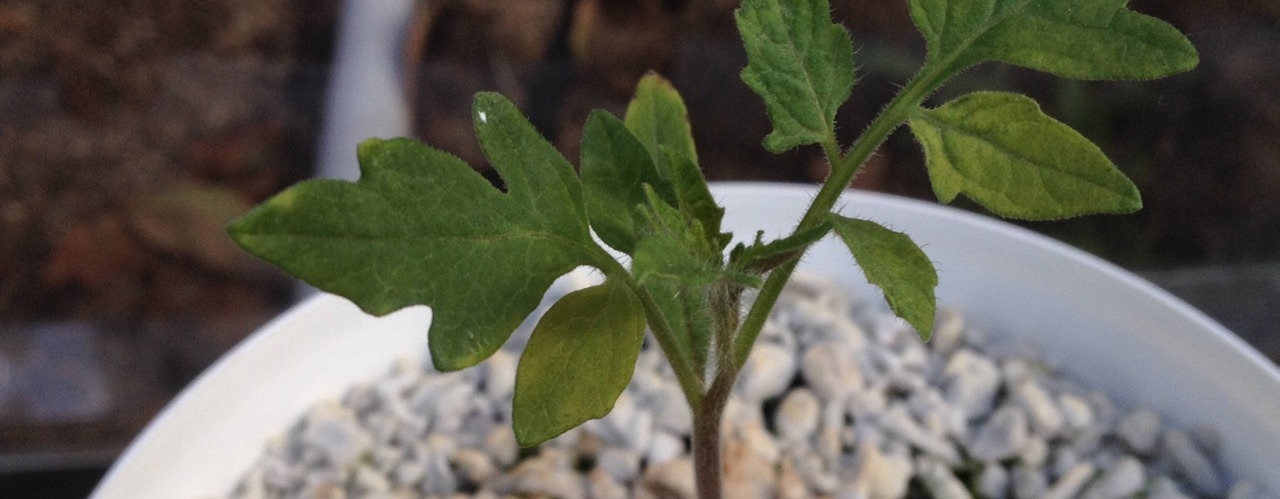Our new aquaponics system is up and running, and supporting some healthy tomato seedlings. It is a gravity recirculating system driven by a solar pump. Here I’ll outline the basic system, with reasons and tips for starting one, and plans for the future.
Why aquaponics?
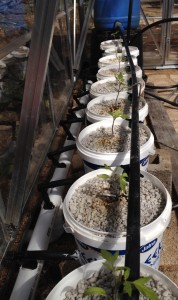
Aquaponics is an extension of hydroponics, that is growing plants in a nutrient solution using a soil – free system. The aquaponics dimension uses a fish tank to balance the nutrient solution, extending the setup to an ecosystem, rather than a throughput of fertiliser. Aquaponics uses a much bigger reservoir for the nutrient solution, effectively a big fish tank, and the combination of the fish, a ‘ballast’ of microorganisms, and the plants, keeps the nutrients in a useful balance. The key is the nitrogen compounds in the nutrient solution. Plants avidly take up nitrates for growth, and fish excrete ammonia. The microorganisms convert ammonia to nitrates, and so provide the link between fish and plant. By removing the nitrates (and ammonia), the plants keep the water safe for the fish.
Nutrients can be added to the system as fish food, or if the fish are omnivores, through the growth of algae and small organisms in the water tank, in contrast with hydroponics which requires regular disposal of the nutrient solution and renewal with fresh (bought) nutrient mix.
Our impetus to try aquaponics was the generous gift of two greenhouses from my father. He has always been keen on hydroponics, and thought it would be a useful extension to our vegetable production. He also gave us a manual ‘Hydroponics for Everyone’ by Struan K Sutherland, which outlines a variety of home systems.
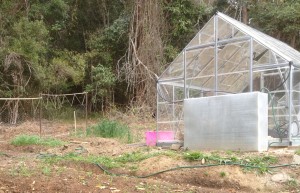
The question then was to find a fit with our conditions. We have good soil, plenty of space, a warm climate, plenty of water, and no serious pest problems, any of which can be limiting factors to drive uptake of hydroponics.
The main reason for aquaponics here is the greenhouses which keep the plants dry. The wet weather here tends to spoil tomatoes both in Summer and Winter. Eggplants also suffer. So my first crops will be tomatoes, until I have a better idea of how the system will work best. By keeping the greenhouses fully ventilated, the temperature stays somewhat warmer than outside, boosting growth, but the aquaponics system allows me to keep the roots wet and fertilised, while the leaves and fruit stay out of the weather.
The aquaponics system
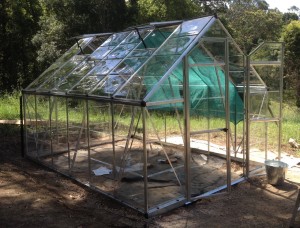
The greenhouses are the central element. They are two 2.4 x 3.6 metre structures with polycarbonate and aluminium frames. We placed them on quite heavy pavers, which keep them clean and weed-free but also maintain thermal mass.
The pond is a 2 x 1 x 0.4 metre rectangle, dug into the ground and lined with standard plastic pool liner. The plastic is anchored and stabilised with wooden sleepers. We have put a shade cloth canopy over the pond.
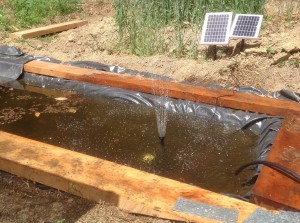
The pump runs the system. It’s a solar pump, with two panels, rated for a pond of this size, and to pump up to 2 metres elevation.
The containers are recycled 2 litre yogurt pots. I drilled 13 mm holes near the bottom to take the outlet pipes. The 13 mm irrigation piping I used is easy to work with and fits snugly in the holes, forming a watertight seal with a little silicone.
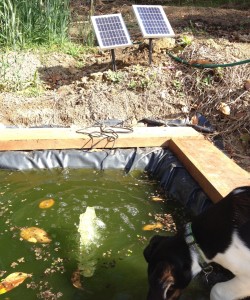
The growth medium is horticultural perlite. I bulked out the bottom of the pots with some roughly broken pumice, just to provide some coarse structure to the cm or so of deadspace which holds water.
The plumbing is mainly 13 mm black irrigation tubing. Water pumps from the pond to a 25 litre header tank. A tap fitted at the bottom connects directly to irrigation tubing that runs along the top of the pots. Each pot has a dripper which supplies a steady gravity flow of nutrients while the header tank has a stock of nutrient. Nutrient flows out of the pots and into holes drilled in a length of 40 mm polythene piping, which then drains back to the pond.
The plants
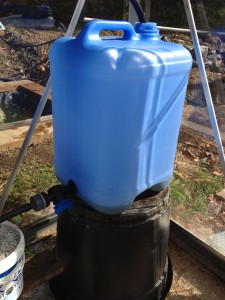
I’m trying tomatoes for this first run. As I mentioned above, although we can grow tomatoes all year round here, the heirloom cultivars tend to be spoiled by our bouts of wet weather. For instance my crop of ‘Thai Pink Egg’ fruited will this Winter, but almost all were spoiled before ripening by small lesions on the skin, while trial pots in the greenhouse have ripened without blemish.
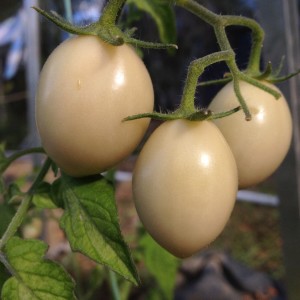
An easy way to raise seedlings for hydroponics is to use little peat pots. A single tomato seed in each pot gives a good germination (my last was 9/10) and the seedlings will grow on to a useful size. You can then put the whole peat plug straight into the hydroponic medium without disturbing the roots or introducing soil into the medium.
The fish
While aquaponics can be used to grow a handy supply of fish, I am using local fish from our dam to stock the pond, at least while the system is running up. These are abundant small fish, like gambusia, but I’m yet to identify them, and they are mainly there to eat mosquito larvae and maintain the pool ecosystem. Later we might get commercial fingerlings like perch, or maybe crayfish. I’m kind of surprised at the density of fish that sites say can be managed; our 800 litre pond should carry around 30 table fish, which would be a handy harvest through the year.
Further adjustment
The system currently has no sand filter, which I need to add. I’m thinking a recirculation arm from the solar pump which constantly runs a trickle through a tank of sand should work. This should act like an aquarium filter, allowing the water to be both filtered and treated by organisms in the sand.
The solar pump is what drives the whole system. The greenhouses are at the ‘Midlevels’ garden, a few hundred metres from our house, so running power down there was not practical. I was surprised by the power of the pump. It fills the current reservoir in a few minutes (which then slowly drains out through the pots), so there is plenty of scope for expansion to, say, four lines of 20 pots each. The solar pump also suits the system well as it pumps when the plants need water. One pumping each sunny morning keeps the pots moist, and there is always a small reservoir of water in the base of the pots to keep the roots humid.
As I had the pond open to the sun and charged with nutrients, a bloom of green algae rapidly formed, but hopefully this will be fixed by a combination of shading the pond, adding the sand filter, and the water ecosystem stabilising.

